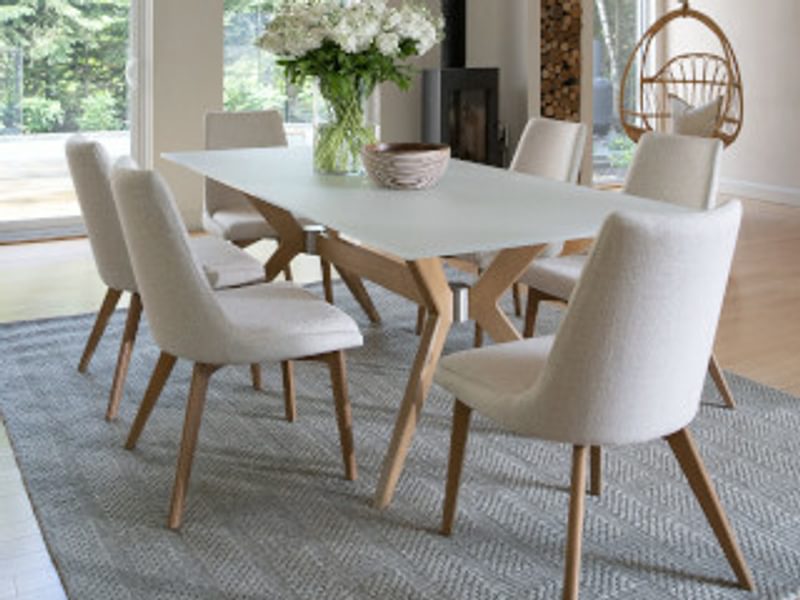Northampton: (413) 586-1464
Maynard: : (978) 243-0370
Northampton: (413) 586-1464
Maynard: (978) 243-0370
Northampton: (413) 586-1464
Maynard: : (978) 243-0370
Northampton: (413) 586-1464
Maynard: (978) 243-0370

(This post was adapted from "The Art of Dining" by Anick Lamothe)
It can be quite unpleasant to sit down for a delicious and friendly meal in a more formal setting and find yourself squeezed between two guests. Time drags on as shoulders are pulled in, elbows constrained in an attempt to become as small as possible and hope that dinner will end quickly.
This was certainly not the intention of the host who undoubtedly wanted to show their guests a good time
Whether when entertaining or making a purchase decision, there are rules to follow regarding the number of chairs to place around a table. Here’s a guide to seating arrangements for your dining table.
The golden rule for comfort at the table is the amount of space allowed for guests, but also the space between the table and the nearest wall or piece of furniture. So keep the following measurements in mind:
For example, during a friendly meal, a 6-foot rectangular table allows seating three people on each side. However, length is not the only factor that determines the number of chairs, the shape of the table and size of the chairs also have to be factored in.
"Since they’re smaller, it can be a good idea to have the kids sit on benches. They’ll be thrilled to sit there and to be able to easily slip off after being excused from the table to go play!"
Whether round, rectangular, oval or boat style, the shape of the table will influence the number of chairs you place around it.
If you have a large family or enjoy entertaining large groups of friends, but your room is neither very large nor is it part of an open plan, a rectangular table will be your best choice if you need to add more chairs.
In fact, depending along its length, this type of table can comfortably accommodate two to twelve people, since a chair can be placed at each end, thus saving two seats. Being narrower than a square table, it will take up less space in your dining room or kitchen.
Because of its shape—and if you are trying to maximize the space in your room for ease of circulation, a consideration worth remembering is that it is more difficult to place several chairs around a square table
Although it takes fewer chairs than the rectangular table, a round table is remarkably well suited to conversation as guests are all facing each other. On the other hand, the larger the table, the more difficult it will be to reach the dishes placed in the center.
Like the rectangular table, the oval table offers the possibility of placing several chairs, and thus seating a good number of people. However, guests at either end of the table may be touching each other, as space is more limited. Also, try to avoid placing a right-handed person next to a left-handed person at the end of the table, as the right-handed person cutting food could cause problems for the left-handed person trying to eat the food! Apart from these minor inconveniences:
To avoid cluttering a room with too many chairs, those who occasionally entertain larger groups will be wise to opt for an extendable table. The question is: how many additional chairs can be placed for each removable leaf of the table?
Generally speaking, depending on their size, one leaf will allow for two additional chairs, two leaves will accommodate four additional chairs, which means four more guests for a joyful gathering.
If you prefer simplicity to more formal dining, you can reduce the space required between each guest. A table that is at least 30 inches wide allows dishes to be easily placed in the center, making the host’s evening more enjoyable as there will be no need to keep getting up to serve guests.
The number one rule for a memorable meal spent in good company is to see to the guests’ well-being, ensuring that conversation flows more smoothly. To this end, the space allocated to each person and their comfort are essential to success.